Lectric XP 4 (500W) Review | Our Best Budget XPerience Yet?
The 4th generation of Lectric’s flagship folding e-bike is among its best to date. It’s packed with value, great performance, and a range of uncommon features for its price.
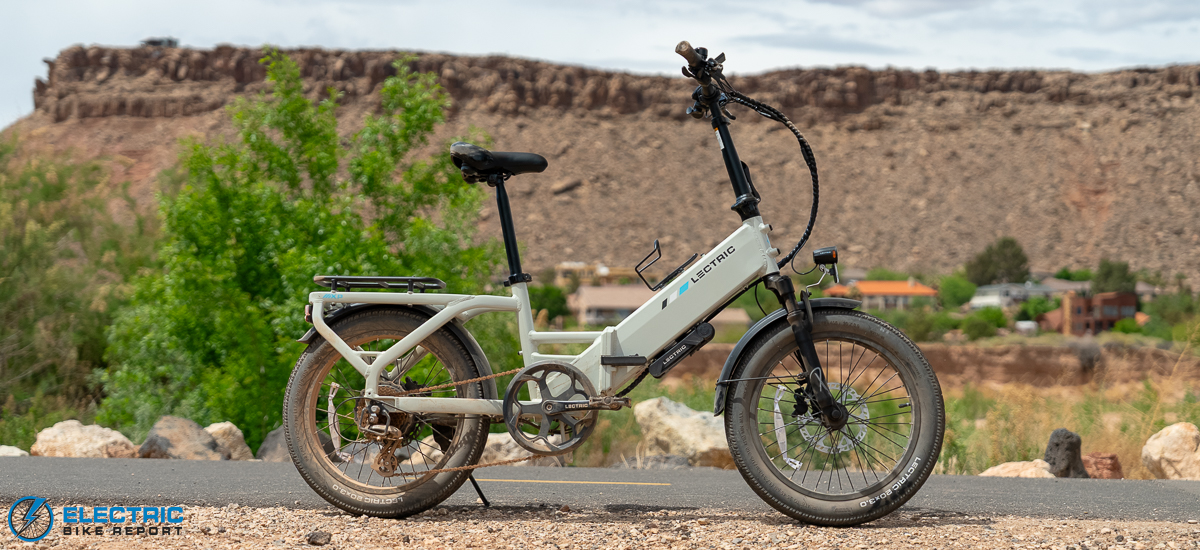
Throughout our history of testing and reviewing e-bikes, the $1,000 mark has generally been the point at which a bike’s cost and quality are balanced well enough to earn our recommendation. With a handful of exceptions, Lectric has largely dominated our list of approved affordable e-bikes, with the XP line of folding e-bikes leading the charge.
The original model of the XP propelled Lectric toward success; its popularity among RV enthusiasts and entry-level e-bikers formed the brand’s foundation. Lectric built upon that base with each new generation of the XP, and through a wide range of its other affordable models, to reach its current status as a titan in the industry.
The XP4 is the newest generation of the brand’s flagship. As with previous versions of the bike, it boasts a variety of upgrades and new features—along with a fully redesigned frame—all while maintaining its starting price of $999!
In addition to relatively standard features, such as a 500W rear hub motor and a modest 499-Wh battery, the bike includes a lengthy list of uncommon features for its price. These include a torque sensor, integrated turn signals, a custom color display, and a handful of trim elements that stood out as feeling better-than-average for a budget-friendly bike.
Lectric also offers an upgraded version of the XP4 with a 750W motor and 840-Wh battery, as well as a few other notable enhancements, though we’ll save that for a separate review.
Our team had the opportunity to test both versions of the bike at Lectric’s announcement event at the Grand Canyon, but we brought the XP4 back to our home base in Utah for a more thorough evaluation. See below to learn how it compares to the best folding e-bikes we’ve reviewed when we put it through our series of standardized performance tests!
Class 2 (throttle to 20 mph)
Class 3 (pedal assist to 28 mph)
 Pros
Pros- Starting at $999, the XP4 is simply one of the best value e-bikes on the market. With industry-wide cost increases at the time of our review, it’s even harder to beat this price!
- It has tons of uncommon features at its price point: a torque sensor, turn signals, a color TFT display, quick-release pedals, and lots more.
- The bike’s pedal assist system offers a blend of responsiveness and ease, with customizable throttle speeds, Class settings, and motor pep.
- The bike feels sturdy and stable thanks to its beefy, redesigned frame (its looks are also a big upgrade).
- Lectric’s custom hydraulic brake system is powerful and extremely effective. See our Brake Test section below for more details, but the XP4 has one of our best test results yet!
- We liked the new custom user interface. Changing the bike’s settings through its display menu is easy and totally user-friendly.
- The bike fits a wide range of riders with both a high-step and step-thru frame. The full recommended height range is 4’10” to 6’3”.
- Shoppers looking for more power can upgrade to a 750W motor and an 840-Wh battery for an additional $300.
 Cons
Cons- When folded, parts of the fork contacted and scratched the frame. Protective rubber bumpers would likely solve the issue.
- As a tradeoff for the sturdy frame, the XP4 weighs a hefty 72 lbs, making it relatively difficult to lift without an extra set of hands.
- Battery: 48V, 499Wh (10.4 Ah)
- Display: Backlit 3.5” TFT color display
- Motor: M24 Stealth rear hub motor, 500W (1,092W peak), 55Nm torque
- Headlight: Integrated LED, 90 lumens
- Taillights:Integrated LED w/ turn signals
- Pedal Assist: Five riding modes, Torque sensor
- Claimed Range: Up to 50 miles
- Throttle:Left side thumb throttle
- App:No
- UL Certification:UL 2849 & UL 2271 Certified
- Claimed weight: 61 lbs without battery
- Tested Weight: 72 lbs with battery
- Rider height range: 4’10”-6’3”
- Total payload capacity: 330 lbs
- XP4 Unfolded Dimensions: 66 x 18.5 x 47 in.
- XP4 Folded Dimensions: 37 x 17 x 29 in.
- ST Unfolded Dimensions: 66 x 18.5 x 47 in.
- ST Folded Dimensions: 37 x 17 x 29 in. (we measured 35 x 19 x 29 in)
- Brakes:Star Union 602, 2-piston hydraulic, 180mm rotors F/R, 2.3mm thickness
- Fenders:Included, Polypropylene
- Fork:50mm spring travel, preload, lockout
- Frame: 6000 Series aluminum, high-step and ST frames
- Drivetrain:Shimano Altus 8-speed, 56t chainring, 11-32t cassette
- Grips: Lock-on Ergonomic Rubber
- Saddle: Custom sport saddle
- Handlebar: 660mm
- Kickstand: Included
- Pedals: Custom 6000 Series Aluminum quick-release pedals with splined inserts
- Tires: 20” x 3” mixed terrain tires
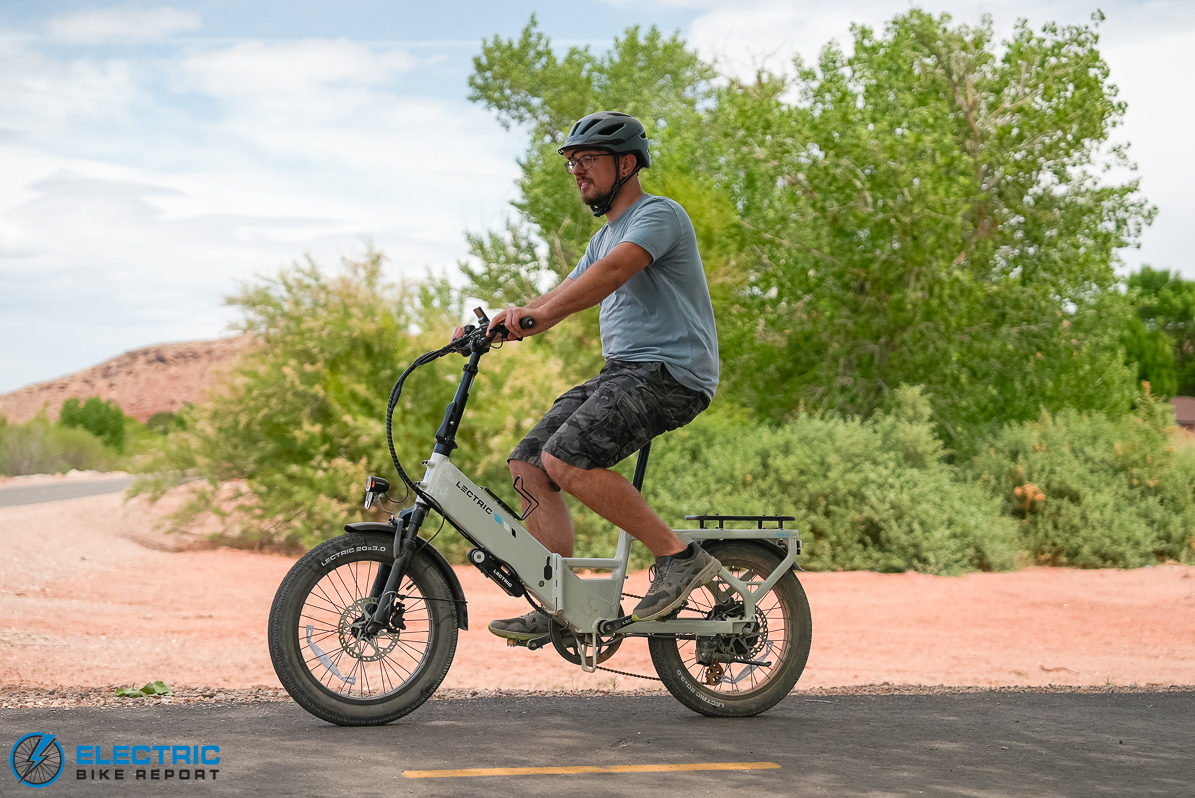
Lectric completely redesigned the XP’s frame, giving it a modernized look and a stiffer, sturdier feel.
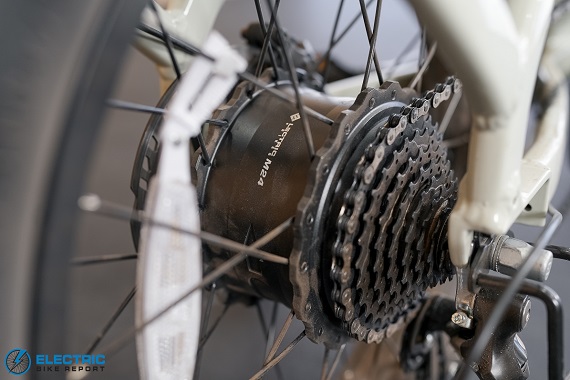
The base model of the XP4 features a 500W rear hub motor and a 499-Wh battery.
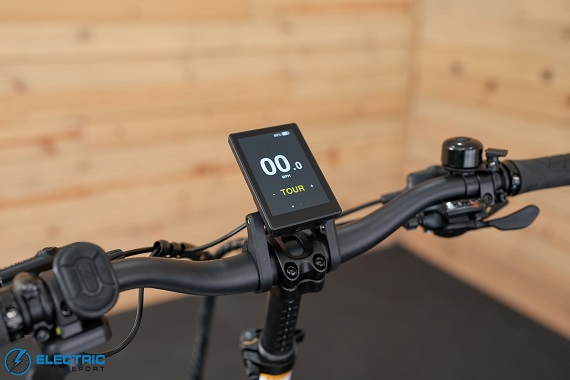
We liked many of the bike’s trim upgrades, including its rubberized button pad and color display.
Lectric XP4 (500 Watt) Review: Speed Test
To begin our testing, I took the XP4 to a flat segment of our local shared-use paths and rode it in each pedal assist setting while recording my average speed. I tested the bike with a maximum pedal-assisted speed of both 20 mph (Class 2) and 28 mph (Class 3), then tested the throttle to see how quickly it reached its maximum of 20 mph.
My results are graphed above.
As shown by the Class 2 data, I experienced relatively even increases in speed when going from Eco Mode to Tour Mode and Tour to Sport. My results leveled off at that point and above due to the bike’s 20 mph limit, despite the motor having enough power to reach higher Class 3 speeds when allowed to.
The Class 3 graph shows larger, but evenly spaced increases in speed from Eco Mode through Sport Mode. When moving up to Sport+ and Turbo Mode, the increases were consistent but less drastic than in the previous modes.
Going by feel, the bike’s power distribution seemed somewhat more evenly distributed than it appears in the graphs, but overall, it balances its power levels and speeds relatively well.
Both the 500W and 750W versions of the bike use a torque sensor with custom programming that sets a “baseline” of power output as long as pressure is applied to the pedals. Compared to other torque sensors I’ve experienced, it’s not the most responsive or natural-feeling, but it did adapt its power output to changes in my pedaling.
Having ridden both the standard and upgraded versions of the bike, I can attest that the base model’s less powerful motor gives it a more natural feel by comparison.
In most of its settings, pedaling the XP4 is an active experience. Interestingly, I noticed that the highest assist level, Turbo Mode, seems to be more cadence-based, outputting enough power to keep the bike up to speed as long as the cranks are turning. This provides users who prefer a low-effort experience with the option to take a more relaxed approach.
Another unique feature of this bike is the Assist Level parameter in the bike’s settings menu, which allows users to choose between two settings: “standard torque multiplier” and “increased torque multiplier.” Essentially, this setting changes the bike’s level of responsiveness and gives the motor more pep.
In my personal testing, I preferred the feel of the “increased torque multiplier,” although it’s worth acknowledging that most of our team didn’t notice a significant difference.
When testing the bike’s throttle, it accelerated steadily while feeling controlled. Some of the e-bikes I’ve tested from Lectric have been relatively punchy, and I liked that the XP4 felt more toned down; this more approachable feel will likely appeal to those who are new to e-bikes or who haven’t been on two wheels in a while.
Lectric also gives users two options in the bike’s settings menu to govern throttle speed. In one mode, each pedal assist setting sets different limits on the throttle’s speed for those who prefer more control. In the other mode, the throttle can reach 20 mph regardless of the selected PAS level.
Lectric’s programming seems to aim for the best of all worlds, giving riders many options for how the bike feels and behaves. More options give the XP4 a chance to appeal to a wider range of riders, and I think it’s likely to be successful!
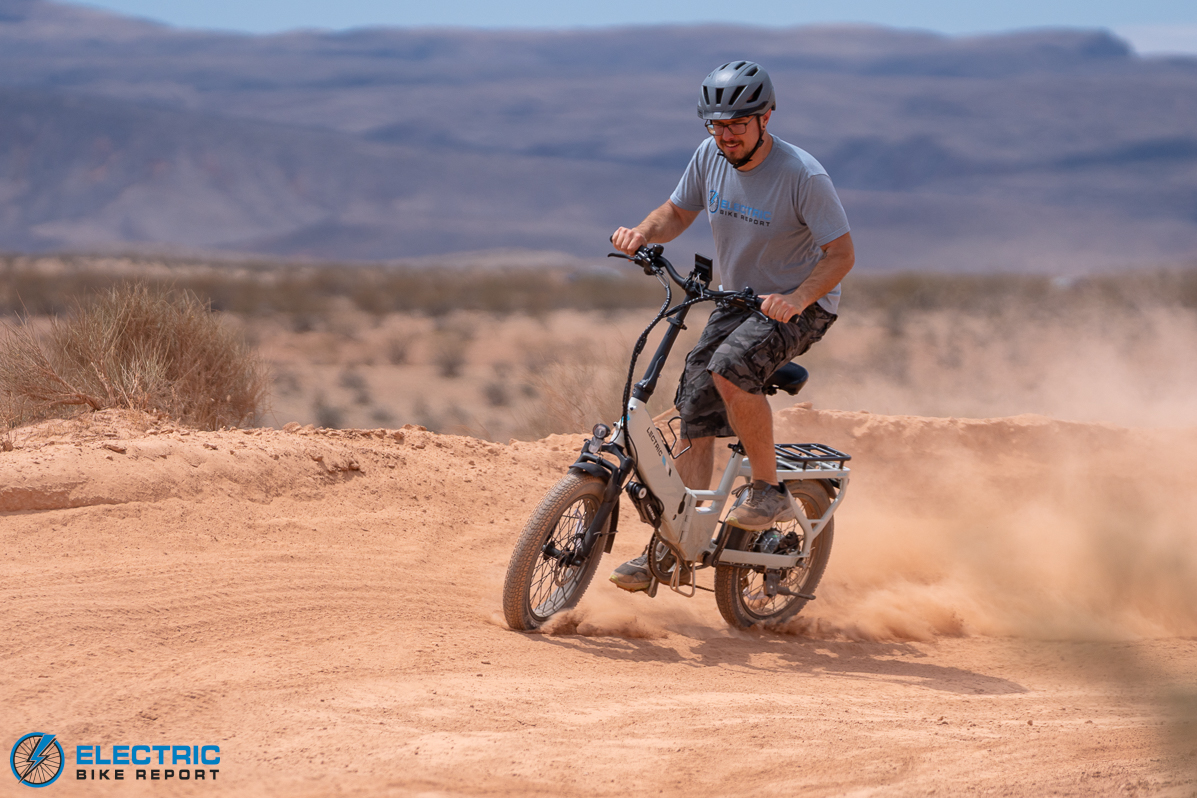
One of the XP4’s highlights is its versatility; it can be stashed in an RV or other vehicle for camping adventures and exploring off the beaten path.
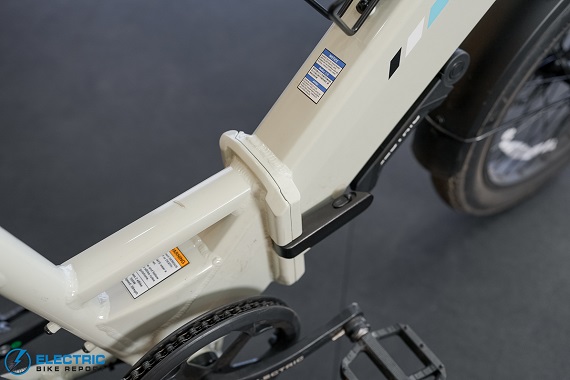
The step-thru (ST) model has a 19” standover height over the hinged frame. We also liked its built-in carry handle.

Keeping pace with similar folding e-bike models, the XP4 offers an 8-speed drivetrain with effective gearing.
Lectric XP4 (500 Watt) Review: Range Test
We tested the XP4’s motor efficiency and battery life in two range tests using the process explained above. As shown, our testers rode 30.2 miles using the bike’s highest level of pedal assistance and 55.1 miles using its lowest.
The XP4’s results were average to somewhat below average when compared to a pool of similar popular folding e-bikes on the market, but there was a good reason for the difference. The models we used for comparison, many of which are priced significantly higher than the XP4, averaged 30.2 miles and 63 miles, using higher-capacity batteries that averaged 687 Wh.
The math is simple; larger batteries typically allow e-bikes to travel longer distances on a single charge, so the XP4’s shorter range in its low-power test makes sense. We’re pleased with its relatively average high-power results, as average performance typically indicates that an e-bike is well-specced and capable of matching its competitors.
From a broader perspective, the XP4 was impressive in its efficiency. We can divide battery capacity by the number of miles traveled to find the number of watt-hours the motor used per mile; Lectric’s e-bike averaged 9.1 and 16.5 Wh/mi, in contrast to the higher demands of other bikes that averaged 10.9 and 22.5 Wh/mi.
While the lower numbers can in many cases be explained by differences in nominal motor power (many similar models have 750W motors vs. the base model XP4’s 500W motor), the XP4 was still able to get more miles from its battery than many of its competitors could. This reinforces the fact that the bike delivers excellent value based on its $999 price!
The bike’s results in our test also show that it can be practical for a variety of uses. Many commuters have less than a 20-mile ride to work, so the XP4 would be capable of at least a single round-trip for those with long commutes (and likely a few trips in most other cases). Its range also makes it well-suited for leisure riding, exploring new cities on road trips, and local errand running.
Lectric pairs the bike with a 2-amp charger that should have a fully drained battery refueled in around 5 hours, but a 5-amp fast charger is available for purchase separately.
Lectric XP4 (500 Watt) Review: Hill Test
Still, we can consider the bike’s peak motor output, compare its results to our averages across all bikes and categories, and also narrow our focus to only other e-bikes with 500W rear hub motors.
At the time of writing, all of the bikes we’ve tested at the Devil’s Backbone averaged results of 1:54 in their throttle tests and 2:02 in their pedal tests, making the XP4 slower than average in the throttle portion and roughly average in the max PAS test.
Focusing only on other e-bikes with 500W rear hub motors, the averages shifted to 2:03 when throttling and 2:16 pedaling. In this lens, the XP4’s throttle time was still somewhat below average in comparison, but its pedal time became notably faster than average.
The XP4’s 500W motor peaks at 1092W and produces up to 55 Newton meters (Nm) of torque. In comparison to other bikes with 500W nominal motors we’ve tested at the Devil’s Backbone, the XP4’s torque output is average (others averaged exactly 55 Nm) and its peak power is well above average (others averaged 738W).
Weighing in at 72 lbs (including Tannus Armour in our test bike’s tires), however, the XP4 is heavier than average (others bikes with 500W motors weighed an average of 57 lbs). As a result, Lectric’s bike has a tougher time moving uphill, so its average-to-slower-than-average results make sense in context.
Overall, the bike proved that it is capable of handling relatively challenging climbs, though it may not be the fastest when the rider relies only on its motor to propel the bike. Riders looking to cruise uphill at a faster pace might want to add some leg power or consider the upgraded XP4 750W model with a more powerful motor.

The XP4 can quickly switch between Class 1, Class 2, Class 3, or a California-specific Class 3 mode with the throttle deactivated.
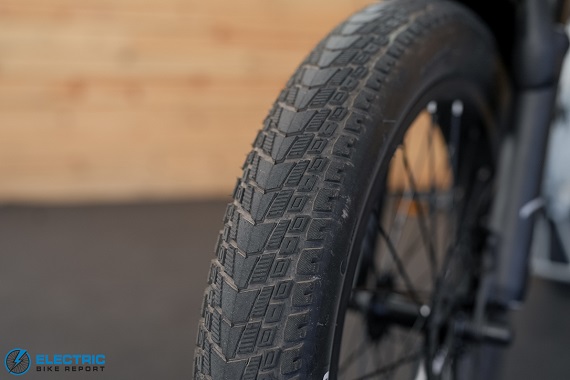
The custom tire tread has a smooth central rib with knobby shoulders for on/off-road versatility.
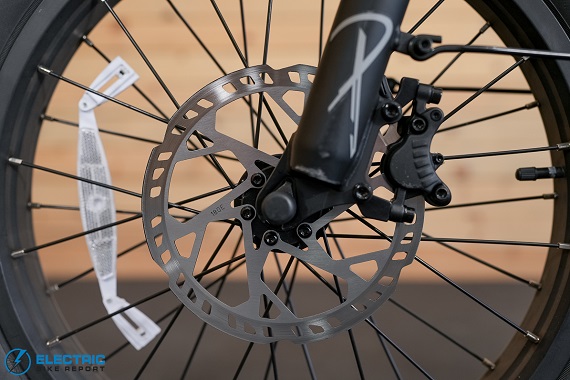
Lectric’s custom hydraulic disc brake system proved extremely effective. You won’t believe how it compares with others we’ve tested!
Lectric XP4 (500 Watt) Review: Brake Test

Most e-bikes are equipped with one of a handful of common, tried-and-true brake systems that provide safe and effective stopping power. We perform our brake test on every bike using the above process to ensure that its system matches its style, speed, and weight; however, unsatisfactory results are uncommon.
As such, our Brake Test isn’t usually a highlight, but in the XP4’s case, we were highly intrigued by the bike’s custom 602 hydraulic brake system, which is made by Star Union. The system has a custom brake lever body with large fluid reservoirs and sturdy aluminum levers. It also pairs 2-piston calipers with 180mm rotors on both wheels.
With this system, the XP4 achieved spectacular results; its average stopping distance of 15’3” is the single best brake test for an e-bike we’ve recorded at the time of writing. For comparison, the average among all e-bikes is currently 21’7”, while the average among folding e-bikes is roughly a foot shorter at 20’8”.
A key difference between this system and many similar models we’ve tested is that its rotors are thicker at 2.3 millimeters, versus the more common 1.8-millimeter thickness. Thicker rotors result in better heat dispersion and improved overall braking performance.
The XP4’s excellent performance was noticeable by feel as well as by the bike’s test score. Braking felt powerful without being too aggressive, and the system modulated speed well when going downhill.
Our entire team has been super impressed with the XP4’s custom 602 brakes, and we can confidently say they are safe and effective.
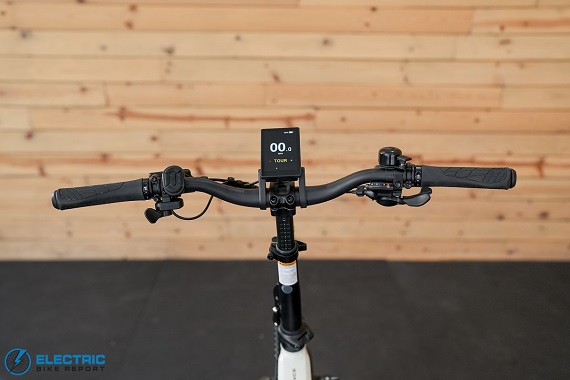
The XP4 has a set of 660mm low-rise handlebars with lock-on ergonomic rubber grips.
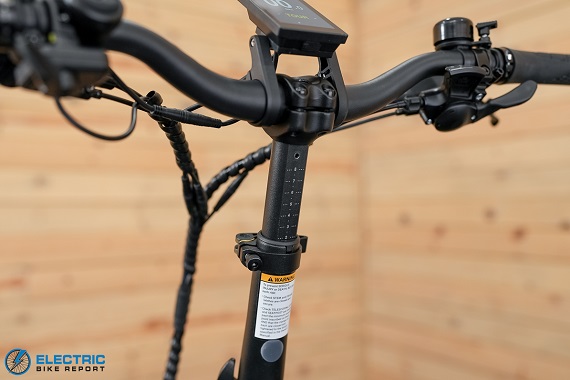
The telescoping, collapsible stem allows riders to adjust the handlebar height and reach for comfort.
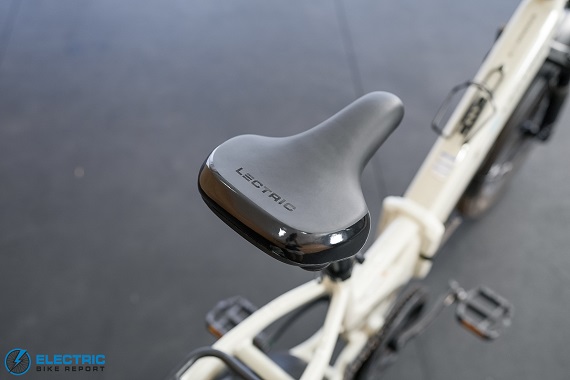
Lectric’s custom sport saddle is mounted to a lengthy seatpost that allows the bike to fit a wide range of riders.
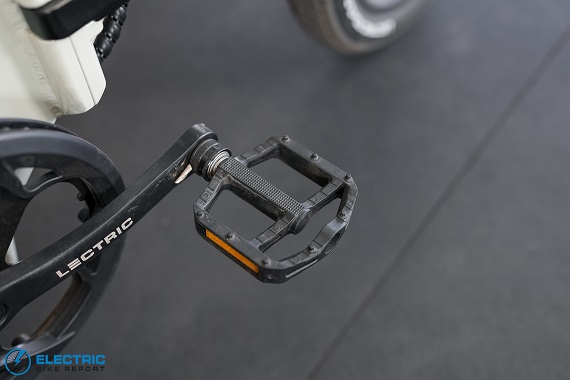
The quick-release aluminum pedals felt grippy and make the bike easier to fold down for storage or transport.
Lectric XP4 (500 Watt) Review: Ride Quality
The subject of ride quality is an overall measure of how a bike feels to ride. It’s influenced by a variety of factors, including sizing, the bike’s geometry and riding position, its motor engagement, its user interface, its overall comfort factor, and many others. I’ll explore and explain these features in detail here.
Starting with sizing, the XP4 is available in either a high-step or step-thru frame with a 19” standover height. Both models are recommended for riders between 4’10” and 6’3”, which is a wide range for a single frame size, but the bike offers an impressive 10” of saddle height adjustment and 4” of handlebar adjustment through the seatpost and stem, respectively.
At 5’11”, near the top end of the recommended height range, I found a comfortable fit with a good deal of room in both the stem and seatpost above my preferred settings. The long seatpost ensured proper leg extension, while the adjustable handlebars offered some adjustment in riding position and fit.
As is common with folding e-bikes, I felt perched relatively high above the frame, but one of the first things that I noticed with the XP4 was its improved geometry. The angle of the stem on the previous version of the bike resulted in an unnaturally long reach, forcing my arms in an extended position, while this new version felt more relaxed and ergonomic (read: comfortable).
Another common aspect of folding e-bikes is somewhat twitchy handling. The XP4 shared this element to some degree because of the small 20” wheels and 660mm handlebars it has in common with other bikes of its style, but its handling was made more balanced and stable due to the bike’s sturdy frame and above-average weight.
Seriously, this bike felt like a tank! In comparison to the XP 3.0, Lectric’s redesigned frame looks more appealing, feels stiffer and sturdier, and brings some much-needed flair to the table. It’s not the lightest or easiest to move around (I recommend an extra set of hands when loading it into a vehicle), but the improvements in ride quality are a worthy trade.
Speaking of improvements, I want to call attention to the fact that this bike simply exceeded my expectations for its feel with many of its trim elements. Previous XP models felt economical, with old-school LED displays, utilitarian button panels, hard rubber grips, etc.
The XP4’s trim included noticeably higher-quality elements common on more costly e-bikes, such as softer lock-on grips, a control panel with rubberized buttons, integrated brake lights and turn signals, and a custom color TFT display.
In contrast with previous models, where adjusting settings sometimes felt like reading hieroglyphics, the XP4 also has a custom UI with a user-friendly settings menu! By holding the + and – buttons, users can alter the torque multiplier, the engagement and limitations of the throttle, and the behavior of the lights, in addition to quickly switching between Class settings.
Another new feature are the XP’s custom 20×3” tires. Instead of the common knobby tires, the XP4’s tires have a hybrid tread pattern made to be efficient on paved surfaces while offering stability when off-roading. I found them generally stable on pavement, hard dirt, and large gravel, though they could be somewhat slippery on sand and pea gravel.
Another element to mention is the XP4’s cargo rack, which is capable of carrying up to 150 lbs. It’s compatible with a range of accessories for carrying cargo or passengers (including third-party child seating). The best part? Many accessories designed for the XP 3.0 are compatible, making it easy for owners of previous models to upgrade.
Finally, let’s discuss the XP4’s folding features. Like Lectric’s previous models and those from many other brands, the bike has a hinged frame and a collapsible stem that functioned well and are intuitive to use.
Unfortunately, some areas of the frame contacted each other when the bike was folded and damaged the paint. The addition of rubber bumpers (such as those on other parts of the bike) would likely prevent this from being an issue.
Otherwise, we were highly impressed with the XP4’s ride quality. It’s a noticeable upgrade from the previous version in nearly all aspects, and when its look and feel is put in perspective with its starting price, we consider any remaining compromises to be more than acceptable.
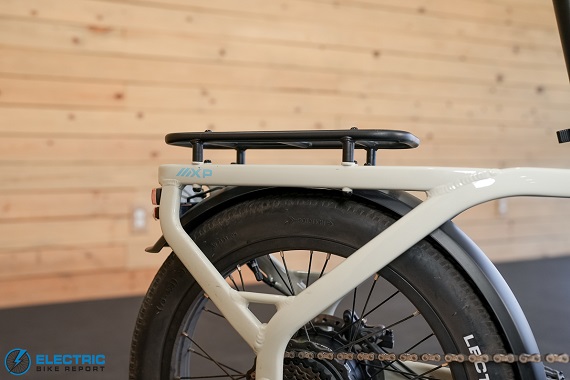
The integrated cargo rack can hold up to 150 lbs of cargo or a passenger.

The bike’s controls are placed within easy reach of the ergonomic rubber grips.
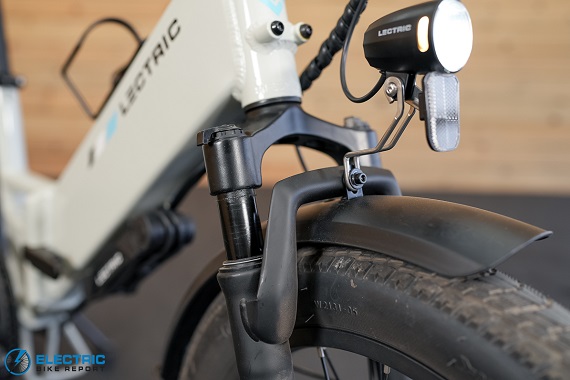
A coil suspension fork offers a modest 50mm of travel to smooth out rough roads, bumps, and dips.
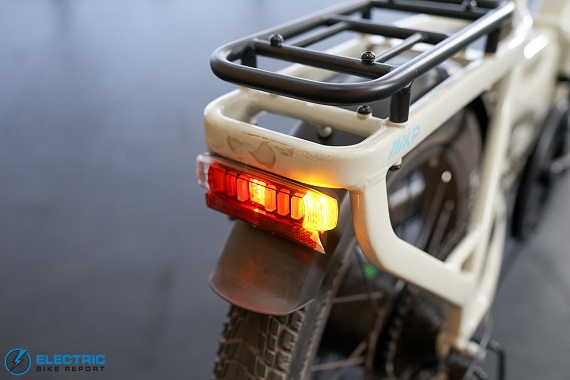
It’s official: the XP4 is the most affordable e-bike we’ve tested with integrated turn signals!
Lectric XP4 (500 Watt) Review: Summary / Where to Buy
From a different perspective, the budget tier has shifted to include e-bikes priced much closer to the $1,500 mark. Lectric has remained remarkably consistent in its pricing, and while we’re not exactly certain how the brand achieves this, the XP4’s price of around a thousand dollars makes it an even better value than in previous years—especially considering its upgrades.
Lectric aims to create e-bikes that are affordable, feature-rich, and value-packed, as well as easy and fun to ride. After riding and testing the XP4, I can confidently say that it checks all of those boxes, even though we have not seen all of its performance results in comparison to many of its peers.
It’s not perfect, and our testing has identified areas for improvement, but in most cases, we believe they are acceptable trade-offs for the price. Most importantly, we hope to see additional rubber bumpers added to prevent unwanted frame contact.
Otherwise, the bike has performed well in our testing (especially when considering its specs and price). As such, I am happy to recommend the XP4 to future riders buying their first e-bike or those outfitting their entire family.
As with previous versions, we consider the XP4 as a great travel companion for RV enthusiasts, but it’s equally suitable for the daily commute to work or cruising around the neighborhood with your friend or child.
Happy Riding! Make sure to let us know if you have any questions or if you think we left anything out in this review of the Lectric XP4 (500 Watt) down in our comments section.




I live in a very hilly area and I am wondering if I would need the 750w version to get me up the hills?
It depends on the length of the hills, the total elevation gain, and your weight plus any cargo you carry around; we might suggest getting the 750W model just to be sure (it has a couple of other nice upgrades, too).